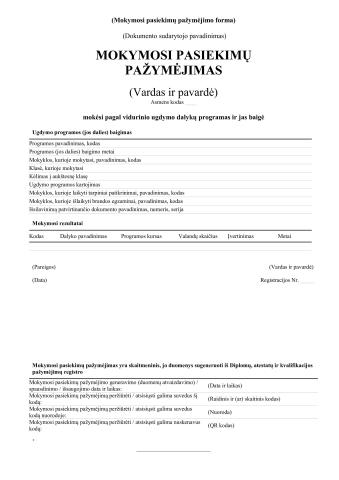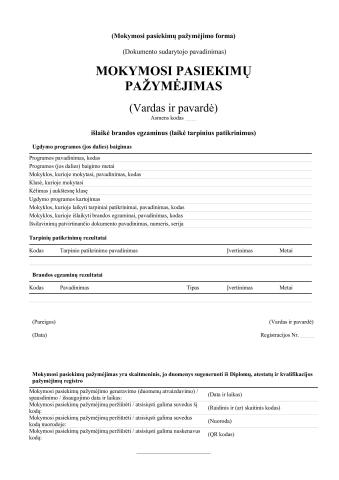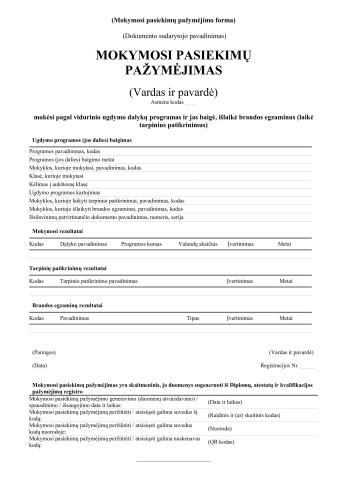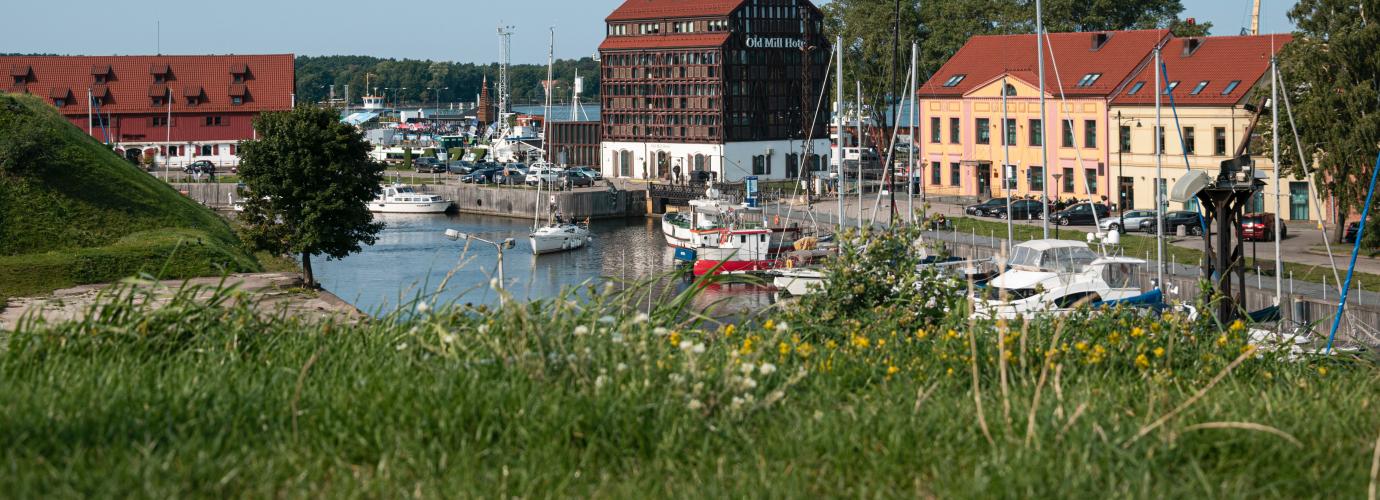Pupil/Students assessment
Procedure for assessing pupil achievements and progress
Assessment of pupils' learning achievements and progress is part of the content of school education. It must be consistent with the educational objectives. The school, in accordance with the legislation and school agreements, develops its own Description of the procedure for assessing the achievements and progress of the school pupils. The director approves it and publishes on the school's website.
According to the Description of Primary, Lower Secondary and Upper Secondary Education Curriculum approved by the Minister of Education, Science and Sport, the school decides on:
- Methods and tools used to assess or/and evaluate pupils’ achievements and progress. The school decides whether it will use: marks (ten-point evaluation system), comments, cumulative points, folder (e-portfolio, e-folder), descriptions of learning achievements, pupil’s characteristics, pupil’s success stories, (self-) assessment, descriptive evaluation, etc.
- Evaluation methods for studying subjects, chosen subjects, subjects modules. For example, if a student in an upper secondary education program intends to choose a degree in sport, it is suggested that the learning achievement in physical education be evaluated using marks and not a record.
- Conversion of assessment to a ten-point system. If a teacher is not using a ten-point system to evaluate pupils’ achievements, the school establishes the time by which the assessment must be converted to a ten-point system. It is not necessary to convert achievements if the pupil is evaluated by “credited”/“not credited”.
- Ensuring consistency between forms of student achievement and progress assessment.
Types of assessment
General education programmes are the main guide for all parts of the evaluation – planning, teaching, recording and discussing assessment information, adjusting education. The school combine formative, diagnostic and summative evaluation in its educational process.
Formative evaluation. Its purpose is to help the pupil to learn, provide and receive feedback, monitor progress, and provide timely assistance. For this, the school puts in place an individual tracking system for each pupil and uses available data, such as the national pupils’ achievement testing and other already created tracking tools or creates and applies its own testing system.
The purpose of tracking the progress of each pupil is to monitor whether the level of competences acquired by the pupil is optimal. Does it correspond to the objectives pursued by him/her and his/her individual powers, aspirations and experiences. Is the pupil continuously and consistently learning new and more complex things, acquiring new skills, and strengthening his/her values? At the same time, the school is looking for ways to promote each pupil’s self-esteem, perseverance, evaluation and improvement of their activity/learning. The pupil, pupil’s parents (guardians, caregivers), teachers and other education specialists all participate in the assessment of each pupil’s progress. This assessment information is taken into account to adjust each pupil’s individual learning pathway.
Diagnostic evaluation. The diagnostic evaluation determines the pupil's achievements and progress in order to plan the further learning purposefully and provide learning aid to overcome any difficulties. The diagnostic assessment of pupil achievements at school is carried out on a regular basis. It corresponds with the training logic, clear evaluation criteria, and school agreements. During the diagnostic evaluation, the school agrees on how to assess the pupil achievements (this can be recorded, for example, by grades, accumulating points, etc.). The information obtained is used to analyse each pupil’s progress and needs by raising further learning and teaching objectives.
Summative evaluation. Pupils’ achievements are formally summed up and evaluated with marks in a ten-point system or by “credited”, “not credited” or “exempt” at the end of the education period. The record “exempt” is recorded if it has not been possible to assess the pupil due their non-attendance at school on the advice of a doctor and is confirmed by an order of the school principal. At the end of the education period (for example, the semester), the subject teacher summarises and captures the pupil’s achievement/results. The evaluation criteria for assessing a pupil’s achievement should be linked to evaluation descriptions described in the general education programmes for a particular subject. They must be known to the learner. Secondary education ends with Matura examinations.
Satisfactory/Unsatisfactory assessment. Scores from 4 to 10, as well as the terms “credited” and “progress made” are considered to be a satisfactory assessment. Meanwhile, scores from 1 to 3, “not credited” and “progress not made” indicate unsatisfactory developments.
Matura examinations and Maturity thesis
A pupil who has completed an upper secondary education programme and who wishes to receive a Matura certificate must pass the Matura examinations (school or state) and can defend a Maturity thesis.
School Matura examination is an examination that has been designed according to the school maturity examinations programme (requirements). The examination is conducted and evaluated in schools and assessed on a ten-point scale (1-10), using a criterion assessment.
Since 2013 pupils from both Lithuanian and minority language schools have the same Lithuanian language and literature Matura examination. There was a transitional period during which the evaluation of this exam was also unified. At first, the assessment norms in terms of literacy and linguistic aspects were the same but the threshold for minority school pupils was lower.
State Matura examination is an examination in which tasks are prepared in accordance with the state maturity examination program (requirements). It is conducted at the state maturity examination centres. me
As of 2013, the assessment of the state Matura examination answer scripts was fundamentally changed. Until then, it was basically norm-referenced containing some elements of criteria-referenced assessment. The results were rated on a 100-point (1–100) scale. From 2013, the state Matura examination tests are more strongly based on the criterion-referenced system. Based on the principles of the criterion-referenced system, the school Matura examination is evaluated according to pre-defined evaluation criteria. The assessment of the Matura examination is attributed to a pre-defined level of state Matura examinations − satisfactory, basic or higher). The minimum pass grade is no longer 1, as it used to be, but is now. A mark between 16 and 35 points is considered as a satisfactory level of attainment, from 36 to 85 points – a basic level of attainment and from 86 to 100 points – a higher level of attainment.
Maturity thesis is a long-term work that a final-year pupil or group of pupils can prepare during their final year in upper secondary education. The Maturity thesis is equal to a school Matura examination, but it is not the equivalent of a compulsory Lithuanian language and literature examination. The Maturity thesis can be done on any subject or several subjects from the individual pupil’s curriculum. A pupil can choose to do a Maturity thesis until the 18th of September of his/hers last year at school. The preparation of the Maturity thesis lasts from 18 September to mid-March. It takes place in the school that pupil attends. The Maturity thesis is evaluated at the Center for Maturity thesis assessment.
Permission to take a Matura examination
A pupil who has completed the upper secondary education programme of a subject and has a satisfactory year-end assessment in it is allowed to take a Matura examination in that subject. The school principal approves by an order this permission. A pupil who has an unsatisfactory year-end assessment is not allowed to take an examination in that subject.
An individual who receives an unsatisfactory score during the main session of the national Matura examinations is allowed to take a school Matura examination in the same subject during a repeat session.
The institutions authorised by the Minister for Education and Science administer examinations and commission learning achievements assessment in other ways.
Participants in evaluation
Learning achievements are evaluated by teachers, education providers, school founders, the Ministry of Education, Science and Sport and its authorised institutions.
Teachers plan and assess their pupils progress and learning achievements. They sum up and evaluate each pupil’s academic attainment. They record the assessment results in the manner established by the school; provide information about performance, achievements and gaps in their knowledge to the pupils, their parents (guardians, caregivers), other teachers and the school administration. Analyse and adjust the pupils’ teaching and learning. And, finally, teachers ensure that pupils experiencing learning difficulties are provided with timely assistance.
The school determines the general procedure for collecting, recording and using information about pupil assessment. It ensures consistent application of assessment methods in the progression of a pupil from one class to another or from a lower stage of education to a higher one and among parallel classes or separate subjects. The school also coordinates the scope and frequency of tests. It provides assistance to pupils experiencing learning difficulties. And last but not least, it evaluates the quality of work performed by individual teachers and the school by pupils’ attainment.
The education department of the school founder administration analyses the information about pupil assessments that it receives from schools and uses it for decision-making. It also takes the social and cultural context into account when making judgements about the efficiency of the school activities. It ensures that the procedure for external assessment of pupils’ attainment should be agreed with the school and its teachers. And, finally, it creates conditions for teachers’ professional development.
The Ministry of Education, Science and Sport approves documents regulating the general content of formal education and pupil assessment. It determines the pupil assessment procedure at the time when the pupil completes the upper secondary education programmes. It also ensures timely analysis of pupil assessment results and their presentation to the pedagogical community and the general public and also the efficient use of that information.
Progression of pupils/students
Transfer to the next grade
A pupil of grade 11 whose year-end scores in all compulsory subjects are satisfactory is transferred to the next grade.
Should some extenuating circumstance interrupt the studies of a 12th grade pupil, he/she is entitled to repeat the course or to continue his/her disrupted study in the following year.
Upon completion of the school year, a final year pupil who has unsatisfactory year-end assessments or has failed in some credits or examinations is not allowed to repeat the year. He/she can eliminate the debts by learning independently at any school implementing the corresponding upper secondary education programme.
Certification
A pupil who has satisfactory year-end scores in each subject in the final year is considered to have completed the upper secondary education programme.
A pupil who has passed the Matura examinations is considered to have acquired upper secondary education. The year of completing the programme and acquiring upper secondary education do not necessarily coincide.
A certificate of learning achievements is issued to a school graduate who did not take the Matura examinations or passed only some of the examinations and/or credit tests required for the Matura certificate.This digital document from 2023 May 1st it is also issued to a person who has the Matura certificate or other document confirming secondary education and who has repeatedly and/or additionally passed the Matura examination and/or additionally or repeatedly studied according to the subject's general program and completed it.
Matura certificate is awarded to a pupil who has completed the upper secondary education programme and has passed the Matura examinations and/or Maturity thesis. In order to obtain a Matura certificate a pupil must pass two Matura examinations (except for cases when a candidate is exempted from the selected Matura examination by an order of the school principal) or one Matura examination and a Maturity thesis. One of these is mandatory – Lithuanian language and literature Matura examination. The pupil choses the type of examination – state or school. Pupils, in addition to the Lithuanian language and literature examination, may choose no more than 6 other Matura examinations and Maturity thesis. From 2016 a pupil wishing to study in a state-funded study place in higher education has to pass the math Matura examination (entrants to arts studies are exempt from this requirement). From the 2017/2018 school year a pupil can choose the Maturity thesis which is equal to the school Matura examination. However, it is not a substitute for the compulsory Lithuanian language and literature examination.
The Matura certificate with honours is awarded to a pupil who who has at least 9 points in the annual and school Matura examinations, who has passed the state Matura examination in at least one subject and has at least 86 points in all the state Matura examinations.
The Matura certificate is issued to pupils from state, municipal and private schools, vocational education and training schools, who have completed general upper secondary education, adult secondary education, secondary education with engineering education programme, secondary education with sports education programme, secondary education with music education programme, secondary education with art education programme, secondary education with artistic education programme.
From 1 May 2023, digital certificates, including maturity certificates, are issued in Lithuania. General education certificates and maturity certificates are issued in the Republic of Lithuania according to the Order of the Minister of Education, Science and Sport On the Approval of the Procedure for the Issuance of Certificates and Maturity Certificates.
Digital (electronic) certificates and maturity certificates are prepared based on the information system tools of the Register of School Pupils and the Register of Diplomas, Certificates and Qualifications, and are accessible (can be viewed, downloaded from an email and/or printed) in the the Register of Diplomas, Certificates and Qualifications.
Certificates and maturity certificates are deemed to have been issued when they are registered in the Register of Diplomas, Certificates and Qualifications (by allocating a registration number) after the school prepares such certificates. The school principal certifies the transfer of the data/records to the register with his electronic signature and is responsible for the accuracy of the data/records in the certificates and maturity certificates.
A numerical code and a QR code are specified in the last table in the certificate and the maturity certificate. The school may provide this code to the pupil if the pupil cannot access the Electronic Government Gateway to download (or view) their certificate and/or maturity certificate. Other persons, national and foreign authorities, may check the fact of issuance of the certificate, the authenticity of the data, etc. by using the code and/or QR code with the consent of the owner of the certificate or maturity certificate (login link: https://www.dakpr.smm.lt/aikos2-dakpr/edocSearch.xhtml) in accordance with legal acts for ensuring the security of personal data.
More information on how to issue digital certificates and maturity certificates, how to download, view or print the certificates and/or maturity certificates, etc. for students and their parents/foster parents/guardians by logging into the information system of the Register of Diplomas, Certificates and Qualifications is available on the website of the National Agency for Education.
Form of Matura certificate issued from 2023-05-01 to 2024-05-14
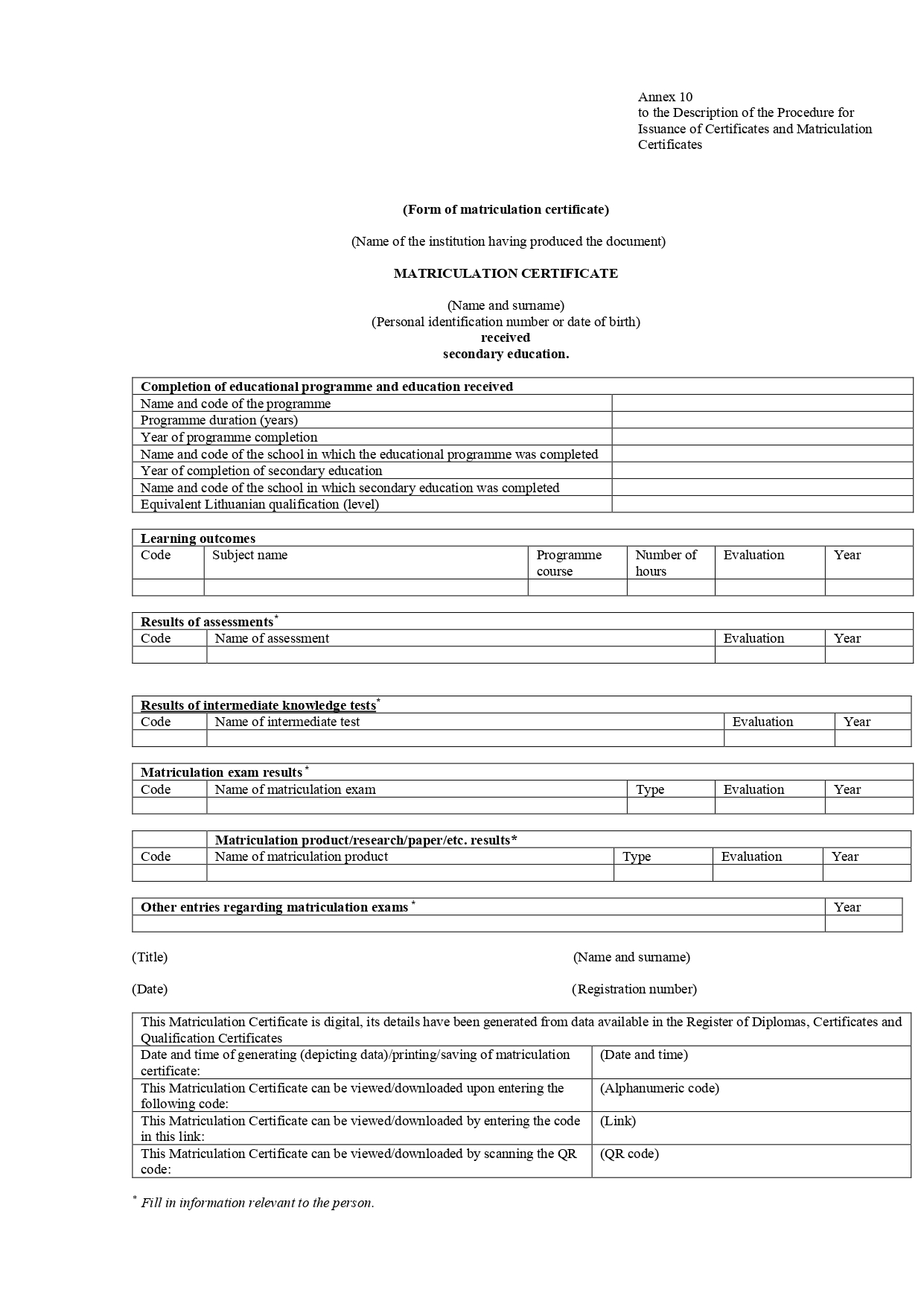
From 2024, Lithuanian school graduates who pass the matriculation examinations will receive a digital Matriculation Certificate in Lithuanian and English. This is enshrined in the amended Procedure for the Issuance of Certificates and Matriculation Certificates which will enter into force on 15 May 2024.
The Matriculation Certificates can be accessed (viewed, downloaded and printed) at the Register of Diplomas, Certificates and Qualifications. Certificates are deemed to have been issued when registered in the Register of Diplomas, Certificates and Qualifications (by allocating a registration number) after the school prepares such certificates.
To have the Matriculation Certificate approved by a notary public, it must be first downloaded and printed from the Register of Diplomas, Certificates and Qualifications and signed by the school principal, either by hand or electronically, and stamped with the school seal. Afterwards, a notary public certifies the Matriculation Certificate by issuing the Apostille.
The amended Procedure has also changed the form of the certificate of learning achievement issued to a person holding the Matriculation Certificate who has additionally taken or retaken the Matriculation Exams (to obtain a higher score) and/or completed the specific subject course (to obtain a higher annual evaluation).
Bilingual Matriculation Certificate form
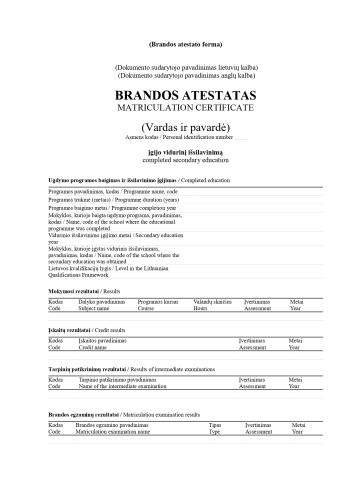
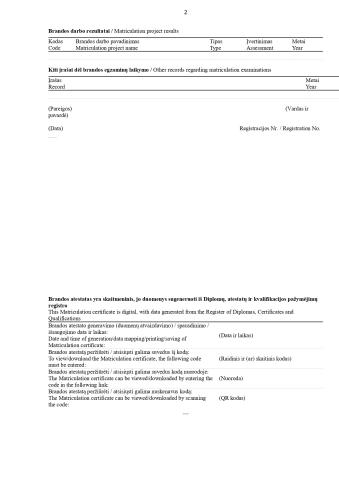
Form of the Certificate of Learning Achievement
